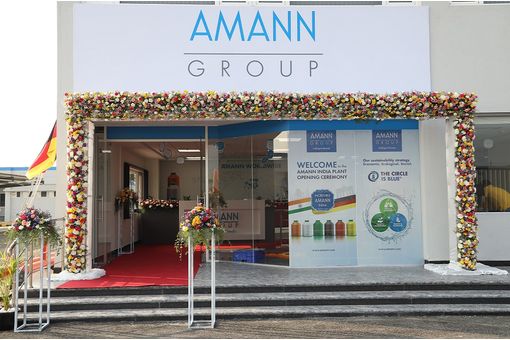Interviews
News Flash
Research project on 3D fibrin textiles for biomedical sector
15 Nov '10
5 min read
The goal of the PANAGENESI project is to optimize the rooting of islands in the transplant site through the use of fibrin variable circular section scaffolds, consequently reducing the number of pancreatic islands necessary for the transplant's full success and prolongation of their function over time. The scaffold is essentially a tubular textile article with a small diameter, comprising a sequence of lobated structures (choked sections alternating with broader sections), with a variable cross-section and three-dimensional type internal structure (internal criss-crossing), produced using fibrin yarns.
For the manufacturing of this tubular textile, COMEZ has designed an innovative electronic double needle bed warp knitting machine, with a working width of 800 mm, in gauge 20 n.p.i. and with 8 knitting bars, for independently controlled pattern making. The knitting bars, as for the finished product take-down and yarn feeders, are controlled by versatile electronic actuators which provide excellent dynamic performance and positioning accuracy.
This machine opens up new fields of application for warp knitting technology:
- applying the most advanced mechanical and electronic technologies.
- capable of operating at a very high accuracy rate.
- can process yarns of various types, structure and composition.
- sophisticated construction design, yet flexible in its operation and versatile in the multiple textile structures it can create.
This machine is especially suited for the production of complex articles that can find applications in a variety of medical/hospital fields, and technical and industrial sectors in general.
The double needle bed machine can create spaced (3D) fabrics comprising two external fabrics forming the two faces of the fabric itself, combined by an internal structure. The possibility of distancing the two needle beds allows for the gap between the two external fabrics to be increased or decreased. The variability of the circular section 3D tubular article is obtained by modifying the interlacing movement which constitutes the fabric's structure, varying the feeding of the yarns and number of stitches per centimetre.
The positive feeding of the threads allows for the processing of very fine yarns with very little resistance to mechanical action, such as fibrin. Two points of excellence in Lombardy, the respective “know-how” in the fields of textiles and medicine, are combined to create new solutions for the textile industry, specifically, fabrics in pure fibrin and silk for both biomedical applications and quality garments.
For the manufacturing of this tubular textile, COMEZ has designed an innovative electronic double needle bed warp knitting machine, with a working width of 800 mm, in gauge 20 n.p.i. and with 8 knitting bars, for independently controlled pattern making. The knitting bars, as for the finished product take-down and yarn feeders, are controlled by versatile electronic actuators which provide excellent dynamic performance and positioning accuracy.
This machine opens up new fields of application for warp knitting technology:
- applying the most advanced mechanical and electronic technologies.
- capable of operating at a very high accuracy rate.
- can process yarns of various types, structure and composition.
- sophisticated construction design, yet flexible in its operation and versatile in the multiple textile structures it can create.
This machine is especially suited for the production of complex articles that can find applications in a variety of medical/hospital fields, and technical and industrial sectors in general.
The double needle bed machine can create spaced (3D) fabrics comprising two external fabrics forming the two faces of the fabric itself, combined by an internal structure. The possibility of distancing the two needle beds allows for the gap between the two external fabrics to be increased or decreased. The variability of the circular section 3D tubular article is obtained by modifying the interlacing movement which constitutes the fabric's structure, varying the feeding of the yarns and number of stitches per centimetre.
The positive feeding of the threads allows for the processing of very fine yarns with very little resistance to mechanical action, such as fibrin. Two points of excellence in Lombardy, the respective “know-how” in the fields of textiles and medicine, are combined to create new solutions for the textile industry, specifically, fabrics in pure fibrin and silk for both biomedical applications and quality garments.
COMEZ GESTIONI S.p.A
Popular News
Leave your Comments
Editor’s Pick
































-Ltd..jpg?tr=w-120,h-60,c-at_max,cm-pad_resize,bg-ffffff)





.jpg?tr=w-120,h-60,c-at_max,cm-pad_resize,bg-ffffff)
.jpg?tr=w-120,h-60,c-at_max,cm-pad_resize,bg-ffffff)






